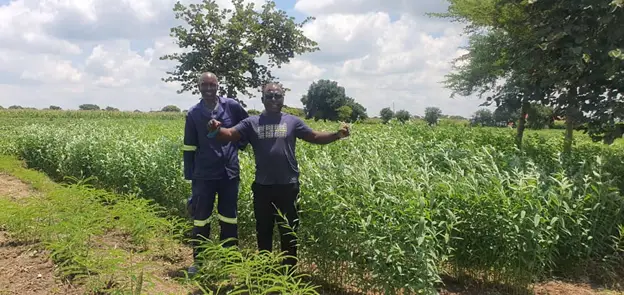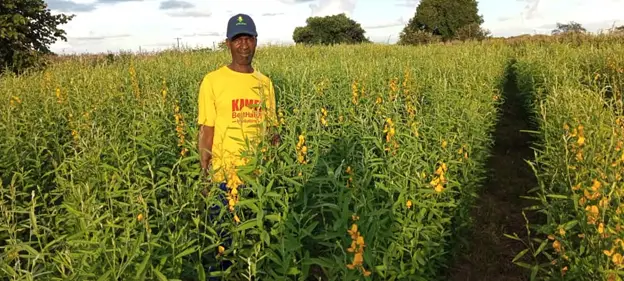
Seed
Schweizer Agriculture kicks off its seed multiplication program by using regenerative farming of Sunn hemp and cover crops in four (4) key regions in partnership with the department of Resettlement Scheme under the Office of the Vice President (OVP)

Schweizer Agri has commenced it’s cover crops, legume seed multiplication and climate resilient program in five (5) key Provinces of Zambia through its 5ha Out-grower Scheme by growing Sun hemp and other cover crops to overcome the cost of urea, NPK fertilizer especially post Covid-19 and the Russian war in Ukraine which has since seen the cost of fertilizer sky rocket and growing food depends on conventional fertilizers and finding alternative resources for nutrients is very crucial for food security of our nation.
Schweizer’ one acre demos in Chisamba-Chibombo districts has just flowered and much of the harvest seed will further be multiplied through an out growers scheme in Chibombo, Kapiri and Serenji of Mumbwa district through an out grower’ scheme.
Our objective is to link over 2, 500 seed producers clustered in cooperatives of 20 members per group based in the resettlement scheme of Central, Eastern, Eastern and Lusaka Provinces access to finance to enable them grow 5ha of seeds for sale with each grouping getting a concessional loan package of inputs such as seeds, 2 x mini tractors, 2 x planters, 2 x harvesters, 2 x shellers and training on how to grow seed and operate an agricultural mechanization enterprise with minimum tillage.
In Sweden most farmers do not till the soil. Hence, I would prefer non-tilling practice. The idea would be to “drill” a 5 cm wide and 10-15 cm deep hole to plant the 3 node cutting in and; https://en.wikipedia.org/wiki/No-till_farming#Origin
“No-till farming reduces nitrous oxide (N2O) emissions by 40-70%, depending on rotation.[49][50] Nitrous oxide is a potent greenhouse gas, 300 times stronger than CO2, and stays in the atmosphere for 120 years”
Sunn hemp is a fast growing legume which originated in India and Pakistan. It is an erect, herbaceous, laxly branched annual shrub growing up to 1.5m high, with bright green, simple elliptical leaves. It bears deep-yellow terminal flowers that turn into small, inflated light brown pods. The seeds are heart-shaped, grayish olive, dark grey or dark brown to black and loosened in the pod at maturity.

It has a well-developed root system, with a strong taproot. Sunn hemp is grown in temperate regions as a summer annual. Although it can tolerate light frost, growth and nitrogen fixation are reduced under cool conditions.
Sunn hemp is drought tolerant and can grow in hot, semi-arid and arid areas with an average annual rainfall as low as 200 mm – but irrigation is necessary for maximum growth and nitrogen fixation. It is adapted to a wide range of soils and performs better on poor sandy soils than most other crops.
However, it grows best on well-drained soils with a pH from 5.0 to 7.5. Sunn hemp can be planted for production of bast fibers used in the manufacturing of twine and cord, high quality paper and pulp.
For fiber, it grows best on fairly light textured soil like sandy loam or loam of at least moderate fertility.
For other purposes, it will also grow well on clay soils and will tolerate low fertility providing that soils are well-drained. Sunn hemp can be planted as a cover crop and green manure to improve and rejuvenate soil quality.
It is excellent to add nitrogen and carbon, for increasing soil organic matter to over-farmed soils, for loosening subsoil, to reduce soil erosion, conserve soil water and recycle plant nutrients. To do this, Sunn hemp need to be plow down before reaching full-bloom stage otherwise it becomes too fibrous. Sunn hemp is known to suppress nematodes and can be planted as a break crop to reduce weed and nematode populations. It produces a compound that is toxic to several nematode species, making it an excellent weapon for pest management and to control root-knot. Sunn hemp can be grown as livestock feed – it is non-toxic to animals. When grown for forage, it can be harvested, starting 6 – 8 weeks after sowing, and then every 4 weeks. Plants will remain succulent until it start flowering when stems begin to lignify.
In Mkushi, commercial farmers have since stopped applying conventional fertilizers to their soils and have now replaced it with various cover crops which are then mixed with animal manure to make compost or make bio fertilizer by allowing microbes to produce more enzymes and organic or plant nutrients; for example on a 1ha plot of wheat where this method is applied has since seen an increase in production of wheat or yields by 1.5ton per ha thus allowing a farmer to make more money in summer when he sales his crop. Rather than selling Sun hemp and other cover crops for the purpose of being harvested.
These cover crops can be encouraged to be grown by small scale farmers who are struggling with risks of low yields caused by climate change to help them restore their soil fertility, manage soil erosion, soil fertility, soil quality, water, weeds, pests, diseases, biodiversity and wildlife in an agro ecosystem—an ecological system managed and shaped by Good Agriculture Practices (GAP).
Regenerative farming has not only provided an opportunity to adopt to climate smart agriculture but also provided employment opportunities for farmers and the market for cover crop seed will always be available because of wheat farmers’ willingness to adopt to this new phenomenal proven to be more cost effective than expensive conventional fertilizers when growing cash crops.
According to on-line searches report in 2020, wheat production for Zambia was 190 thousand tones. Though Zambia wheat production fluctuated substantially in recent years, it tended to increase through 1971 – 2020 period ending at 190 thousand tones in 2020.
Production mainly occurs in the Central Province (49.5%), Lusaka (24%), the Copper Belt (14.3%), and the Southern Province (12.1%).
Considering commercial seed production our small scale seed producers will still be able to make money on such seed multiplication activities and local financial sectors such as insurance and banking institutions who are risk-averse can start also participating in small scale agriculture to create jobs for many to be enabled a good living from this massive opportunity especially the rural youths, women and help poverty alleviation and rural development (PARD).
To become a seed producer for Schweizer Agriculture or to apply for input finance (click here to download application forms, T&C apply)
- Groundnuts
- Cowpeas
- Cassava
- Sunn-hemp
- Sunflower
- Sugar beans
- Soyabeans
- Access to inputs finance
